Night Photography With A Twist: Creating Neon Abstracts!
Neon signs add color to a night image and are a great way to broaden your night time photography skills by creating abstract images. Some of the most famous locations for neon signs are along the strip in Las Vegas and many of the motels and restaurants along Route 66 in Holbrook, Arizona and Albuquerque and Tucumcari, New Mexico. Bourbon Street in New Orleans, LA, and Beale Street in Memphis, TN also have plenty of neon signs advertising their restaurants, bars and live music.
While most of the signs have gone digital, New York City still has a few neon signs, such as Harlem’s Apollo Theatre as does many of the mid-century diners that still exist in Los Angeles. Closer to home (DC), there is Baltimore Avenue in Ocean City, MD, and there are also a few at Glen Echo Park in Glen Echo, MD.
Glen Echo was originally an amusement park in the 1920s until it closed in 1968. In 1971, the Federal Government obtained the land (the Clara Barton National Historic site is nearby). In 2002, in a partnership with Montgomery County, MD which manages the park, the buildings and neon signs were renovated, and twenty years later, the park is now a thriving destination for resident arts and cultural organizations, artists studios and social dance programs.
Several of the almost 100-year old neon signs at Glen Echo Park are used to discuss creating abstract images. To start, a mirrorless Micro 4/3 camera with a 14-140mm zoom lens mounted on a sturdy tripod was used, along with a wired shutter release.
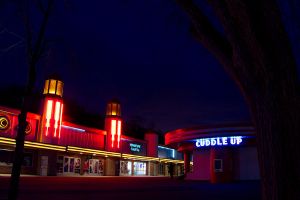 |
 |
The first set of images show a couple of the neon signs that were photographed in a static image during civil twilight. In the first image, you can see the neon discs on the left, along with the Cuddle Up sign on the right. Next is a close-up of the three discs. Several images were taken to determine the exposure settings when a shutter speed of a minimum of three (3) seconds is used. Three seconds is usually a good starting point when the barrel of the lens will be turned during the exposure. This static image of the three discs is also the basis to create the next image. Then the fun begins!
 |
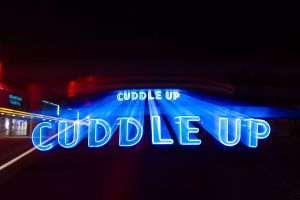 |
In the image on the left, the settings were: F/8, shutter speed of 3.2 sec and ISO 200, and while exposing the image, after 1/2 second, the barrel of the zoom lens is “zoomed out” by turning the barrel of the lens 1/2 turn with a slight pause, then another 1/2 turn and let the exposure finish. If you want to include more circles, you can use shorter turns of the lens barrel. Timing the turn of the lens barrel is everything when making these exposures, so practice turning the barrel of the lens during several test exposures. You will easily see the effects of a faster or slower turn – or a pause in the turn – in your image.
In the image on the right, the settings were: F/14, shutter speed of 3.2 sec and ISO 200, with exposure compensation of -1/3 stop. This image was created by “zooming in”, with the turning of the lens barrel starting 1 second after the start of the exposure. This 1 second pause allows the original scene to be captured before the light trails are created. Then the barrel of the lens is turned slowly and evenly to create those nice, smooth trails. The exposure finished just after the barrel had been fully turned to the zoomed in position, which allows the definition in the lettering to be created.
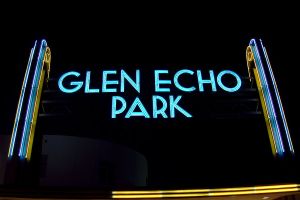 |
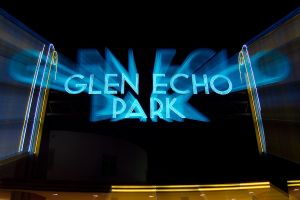 |
Last is the Art Deco Glen Echo Park sign. For this image, the settings were: F/9, a shutter speed of 2.5 sec, ISO 200, with exposure compensation of -1/3 stop. In this image, when “zooming in”, the turning of the lens barrel is stopped before the type is truncated at the edges of the image. Again, there is a slight pause before turning the barrel of the zoom lens begins to “establish” the original image. It took several tries to determine how much to turn the barrel of the lens to keep the lettering from being truncated.
If there are some neon signs near you, try using these techniques to capture some abstract images – we’d love to see them!
Photos by Sherryl Belinsky
